Syn.: Ceranthe acuta (Moench) Opiz, Ceranthe wierzbickii Opiz, Cerinthe acuta Moench
Family: Boraginaceae Juss.

Distribution: Southeastern Europe and southern part of Central Europe (northward to southern Poland and Saxony), from France through Asia Minor, Iran and southern Russia to Altay.
Ecology: It grows in forest margins and on sunny slopes, often in human-altered habitats, from lowlands to mountains. It blooms from April to June.

Description: Biennial, rarely annual or perennial herb, 15–60 cm tall. Stem erect, branched above, often purplish. Basal leaves petiolate, obovate, glabrescent, cauline leaves alternate, sessile, oblong-ovate, often with white spots. Flowers in a terminal, bracteate cyme, bracts cordate, calyx-lobes obtuse, corolla 10–12 × 3.5–5 mm, yellow, sometimes with 5 violet spots in the throat, lobes lanceolate, acuminate, erect, almost as long as the rest of the corolla. The fruit is a nutlet. The species is variable.
Note: The Lesser Honeywort is the host of the beetle Opsilia coerulescens.




These images were taken in Czechia, Moravia, Brno-Hády and Ketkovice (23. 4. 2003 and 26. 6. 2004), and Bohemia, Polabí, Vršek u Vestce (7. 5. 2013).


